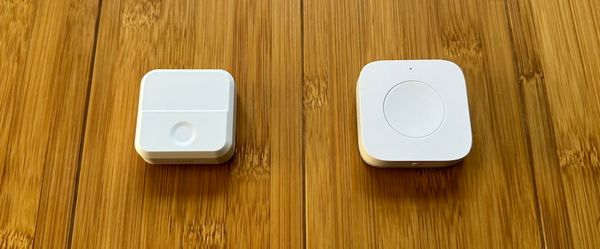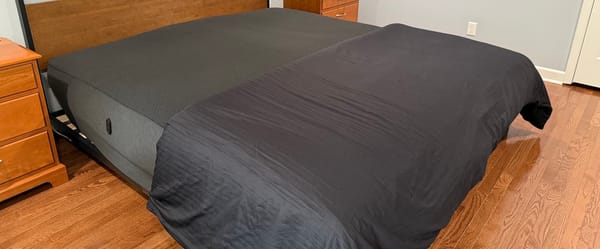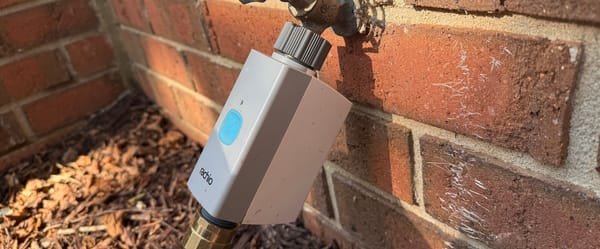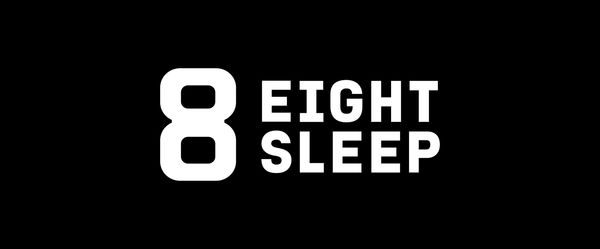Eufy Smart Lock Touch (S230) Review: Great but Not for Apple Users
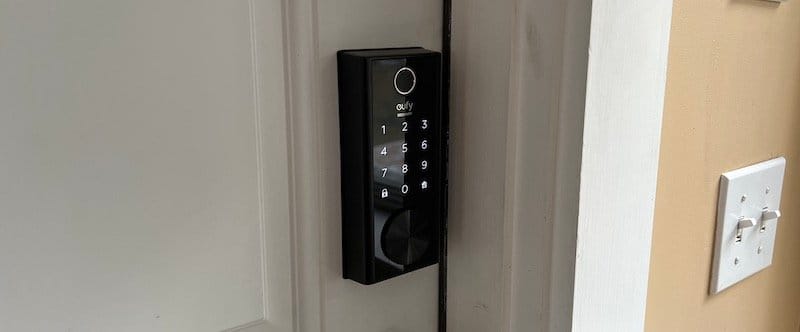
I’ve reviewed more than 14 different smart locks over the last eight years.
I just finished four months of testing the Eufy Smart Lock Touch (S230) that has two features that I’ve never seen in a smart lock that I’ve tested: a replaceable battery and a fingerprint reader.
Plus, the Eufy Lock has all the features you’d expect from smart locks, like guided installation via a phone app, full lock and unlock history, access codes for guests, auto-lock, and control while away from home.
My conclusion? Eufy's rechargeable battery is excellent, and the fingerprint reader is a smart, reliable addition. For its price, it's hard to beat. However, Apple users looking for the best experience, regardless of cost, may likely prefer the Schlage Encode Plus or Yale Assure Plus 2, which offer Apple HomeKit and Home Key compatibility.
Now, let’s go more in-depth with the Eufy Lock. First, I’ll talk about its three design advantages, then five shortcomings, and finally, I’ll summarize all the ways that Eufy can unlock and lock.
TL;DR (7/10 Rating)
Who Should Buy the Eufy Lock:
- You're on a tight budget
- You're an Android user
- Your preferred way to unlock is with a fingerprint
Who Should Avoid the Eufy Lock:
- You want Apple HomeKit or Home Key support
- You want a warning if the door isn't fully shut
Three Advantages
1. Rechargeable Battery
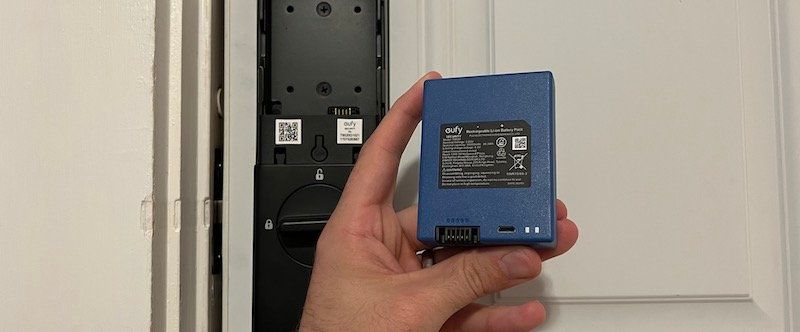
Most smart locks use AA batteries, which last just a few months before needing to be replaced. But the Eufy Lock comes with a rechargeable battery pack that gets recharged via micro-USB.
So far, I’ve had the lock installed for four months and the battery level in the app displays two out of five bars. It’s safe to say you should get close to six months of battery per charge.
Eufy sells a backup battery for $50 to eliminate downtime, but this doesn’t make a ton of sense considering how infrequently you’ll have to charge.
I plan to charge mine just before going to sleep, to eliminate downtime, once my battery gets low. But if I forget to charge before the battery dies, the lock will work as a traditional lock and require a key to unlock.
2. Fingerprint Reader
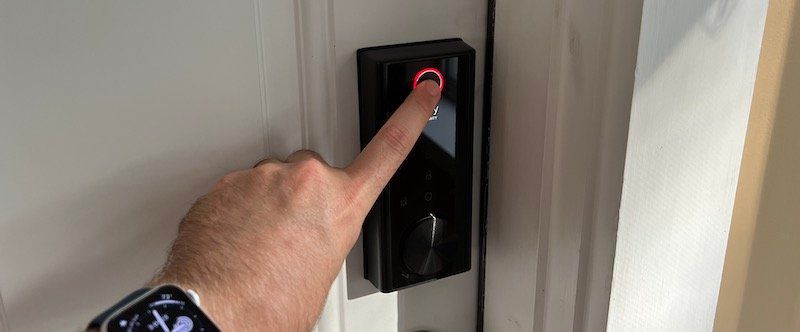
Multiple users can have access to the lock, and each person can register several fingerprints. Adding a new fingerprint is simple: tap on a profile, select "fingerprint," and then "add new print." The app will guide you through the process by having you place your finger on the reader eight times.
When my finger is placed perfectly square on the reader, it works on the first try 99% of the time. But it’s not like an iPhone or a Mac Touch ID where it’ll unlock with just the side of your finger. You need to be a little more calculated with your placement.
Sometimes the reader didn’t work on the first try because the lock wasn’t fully awake, so it had to be activated first.
Overall, the fingerprint reader works well and is a smart addition to a lock.
As for its security? I don’t know how to measure this. However, it has two smart security features that make me feel better.
First, the fingerprint data isn’t stored in the cloud. It’s stored locally on the device.
Secondly, “Wrong-Try Protection” limits the number of fingerprint attempts you’re allowed. In the app, the attempt limit can be modified from 3-10 attempts, and the amount of time where the user is locked out can be modified between 1-3 minutes.
It’s worth noting that the lock isn’t made by a company that has the experience or reputation for securing tech devices with fingerprints, like Apple, Google, or Samsung. But if you’re comfortable using something like August’s Auto Unlock feature, the fingerprint reader shouldn’t be any more or less secure.
3. Keyhole
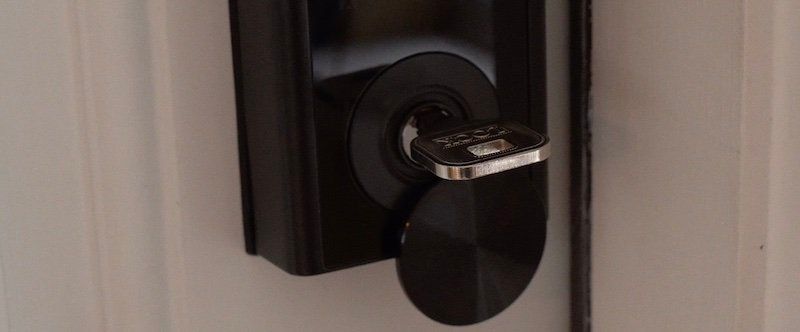
Eufy also has a hidden keyhole. Just lift the black circular metal to find the keyhole, then use the included key. Locks like the Yale Assure have skipped keyholes for aesthetics, but Eufy’s method preserves some coolness but also works practically. A key is a nice failsafe option if something goes wrong with the tech.
Four Downsides
1. No HomeKit or Home Key Support
The Eufy Lock doesn’t offer Apple HomeKit support, which means that it won’t work with Siri or inside the Home app. For me, this is a deal-breaker. As someone with all HomeKit smart home devices, I like to have the status of all my devices in one spot, in one app.
I like the assurance of knowing that my house can be secure and shut down (turns off my lights, closes the blinds, turns down the thermostat, then locks the door) with just one command before sleep in my end-of-night automation.
Apple Home Key is another feature lacking from Eufy. Home Key allowed Apple users to unlock their lock by just pointing their iPhone or Apple Watch near the lock.
But if you’re not a heavy Apple user, HomeKit and Home Key support aren't important to have. Plus, Eufy works with other digital assistants like Alexa and Google.
2. Door Sensing
Eufy has no way of knowing if your door is open. While companies like August use a small magnetic device that goes in the door jam that alerts you if your door is still open. Theoretically, the Eufy app could show your door as locked and secure, but it could be wide open with just the lock latch slid over.
Knowing your door’s status isn't necessary—just extra peace of mind. As long as you close your door tightly, you won’t run into any issues.
3. Weird Syncing Issue
Eufy occasionally has strange syncing errors.
A warning message appeared 10-15 times in my four months of testing that said: “Unable to lock. The deadbolt may be stuck.” The interesting part is that the lock would work as intended and be locked when this warning appeared.
It could be a software bug. Or maybe the motor doesn’t have quite enough power to lock the door fully if the door isn’t perfectly shut. It was annoying either way.
4. Spotty Connection Away from Home
The Eufy lock that I bought (S230) doesn’t need a bridge because it has built-in WiFi, which means that you can control the lock when you’re away from home without any other equipment. This is awesome considering most smart locks require a bridge for remote control!
However, several times, I couldn’t control my lock remotely because it went offline. I noticed this usually happened when the lock hadn’t been used for a few hours. It might be entering a low-power mode to save battery, or it could be a bug that could be fixed with a future software update.
I’m curious if the Eufy models with a bridge have the same issue. Either way, it’s not a big deal—I mostly check the lock right after leaving to make sure I remembered to lock the door.
Ways to Unlock
Eufy doesn’t have Auto-Unlock, utilized Apple Home Key or support Siri, however, there are still plenty of ways to unlock the door. Here's a list in order of easiest to hardest:
- Just place a finger squarely on the reader after half a second, the reader will turn blue and unlock the door.
- Use the keypad. Just tap the keypad to wake it, then enter your code, followed by the checkmark.
- Open the Eufy Security app, then drag the lock icon down to unlock. Sometimes the communication can be a bit laggy, but it works well overall.
- Unlock with Alexa or Google assistant apps or your voice by saying “unlock the back door.” You’ll need to provide your access code via your voice after asking with your voice.
- Use the key and keyhole. This is the last resort because you probably won’t have your key with you (considering the point of a smart lock is to remove the key). But it’s a great option if something goes wrong with the lock.
Keep in mind, if your battery dies before you have a chance to recharge, you can get in your house if you have a USB power bank handy. Just plug the power bank into the bottom port via micro-USB, then enter in your code.
Ways to Lock
- The easiest way to lock the door is to place your finger on the reader.
- You can also push and hold the lock button, but this method requires you to first wake the screen, then hold the button for a couple of seconds, which seems like too long.
- You can lock inside the Eufy Security app by sliding the lock icon down.
- You can lock with the Google and Alexa assistant apps or via your voice. These assistants won’t require a code or need authentication.
- You can set an Auto-Lock timer between one second and three minutes. You can even schedule a time window when you want Auto Lock enabled. Keep in mind, Eufy doesn’t know if your door is shut, so using Auto-Lock can be risky. When I use Auto-Lock with a smart lock, I like the timer between 5-10 minutes, which isn’t even an option with Eufy unfortunately.
Who is this for?
Get the Eufy Smart lock if you want a budget friendly smart lock that lets you open your door with your finger. The fingerprint reader is an easy way for everyone in your household to have access to the lock. Eufy’s rechargeable battery is another great idea that provides convenience and potentially saves money.
For Apple users, you’ll miss out on a few key features I love from other smart locks. While Eufy works fine with iPhones, it’s not compatible with the Apple Home app, Siri, or Home Key. Home Key is the fastest and most secure way to unlock a door, especially in an Apple-based household. For me, it’s a must-have feature, but all Home Key-compatible locks cost over $220. If that’s not a priority for you and you’d rather save some money, Eufy is a solid choice.
For Android users, Eufy is a more appealing option. The only feature you might miss, compared to other locks like Yale or August, is door sensing. However, as long as you close your door securely or use a third-party door sensor, you’ll be all set.
Are there other Eufy fingerprint lock options?
I reviewed the Eufy S230. It's the most expensive model and comes with a rechargeable battery.
If you're trying to save money, the Eufy C220 is similar to the S230, except it uses eight AA batteries instead of a rechargeable one. The batteries should last about eight months before needing replacement. I like the idea of replaceable batteries, and with the S230 costing $60 more, I wouldn’t fault you for choosing the C220. While AA batteries aren’t cheap (a 48-pack costs around $16), they aren’t THAT expensive. I haven’t tested the C220 myself, but since it uses the same software and similar hardware, I don’t expect it to perform much differently.

